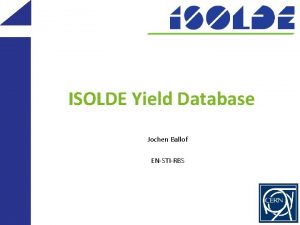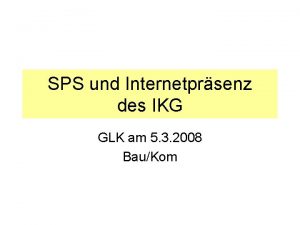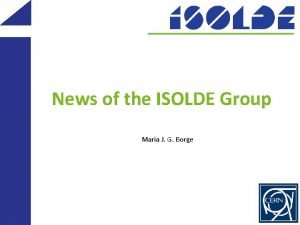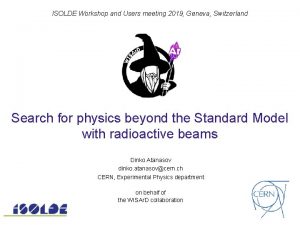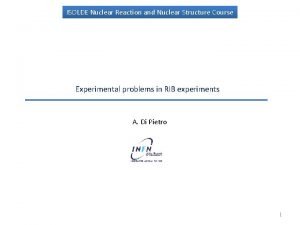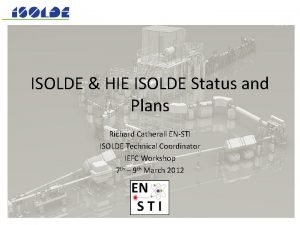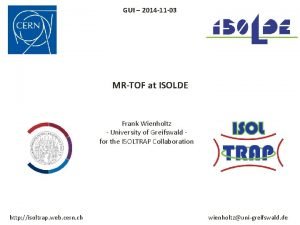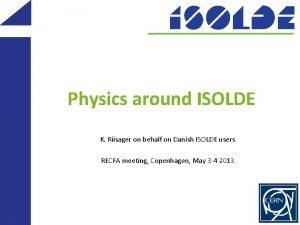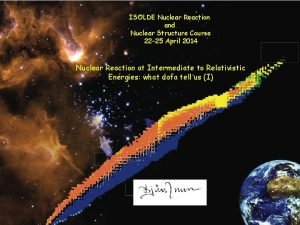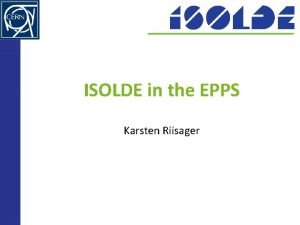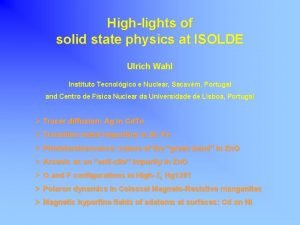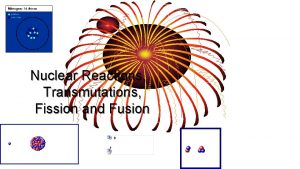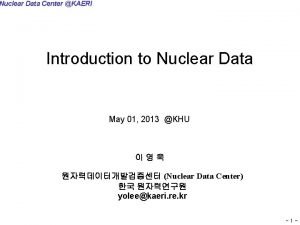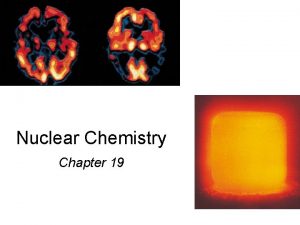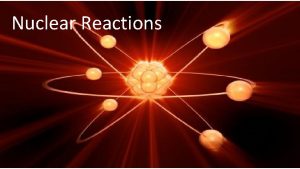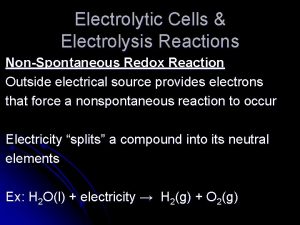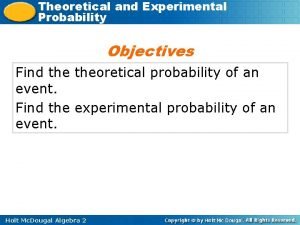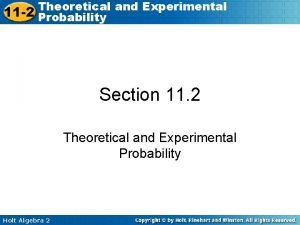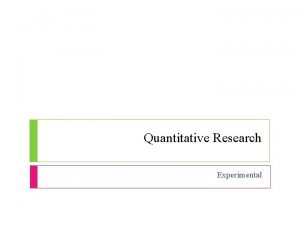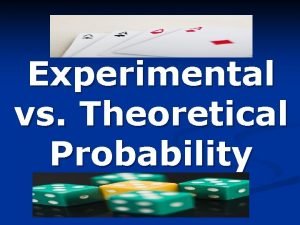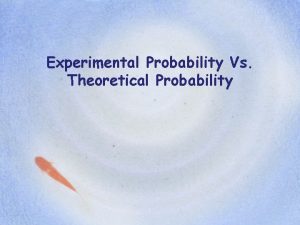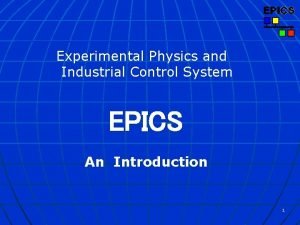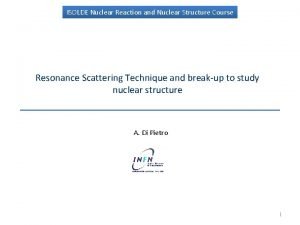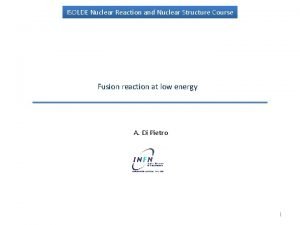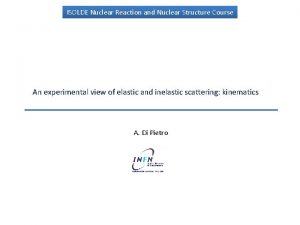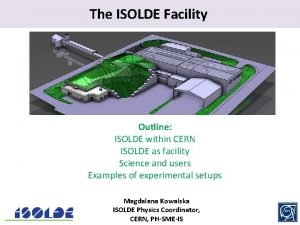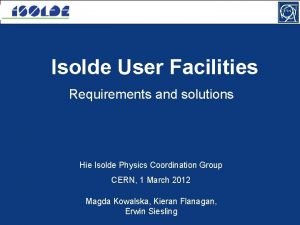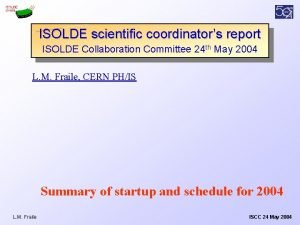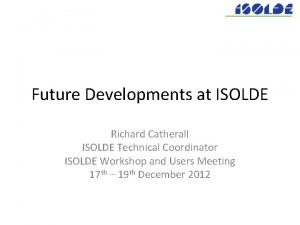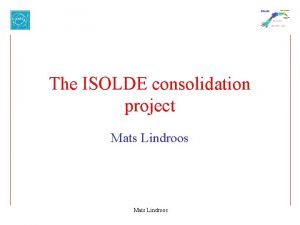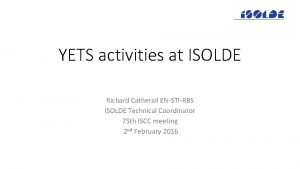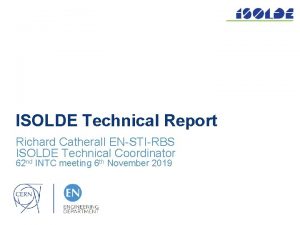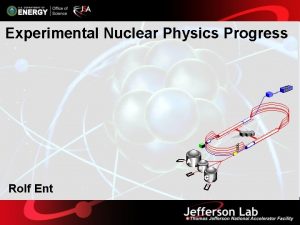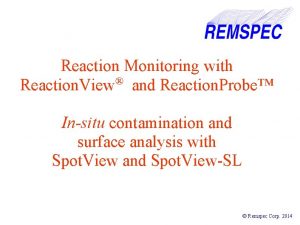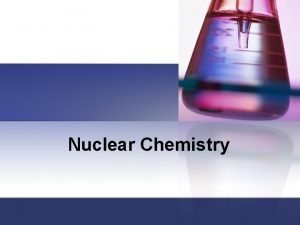ISOLDE Nuclear Reaction and Nuclear Structure Course Experimental







































- Slides: 39

ISOLDE Nuclear Reaction and Nuclear Structure Course Experimental problems in RIB experiments A. Di Pietro 1

Outline of the lecture: RIB production methods Resolutions. Background problems in RIB experiments. Experimental developments. Summary and conclusion. 2

RIB production methods Isotope Separation On Line (ISOL) ( ISOLDE, SPIRAL, TRIUMF) Projectile Fragmentation (PF) (GSI, GANIL, Catania, MSU, RIKEN) In-Flight production (San Paolo, Notre Dame, Legnaro, …. ) Batch-mode production (the oldest approach used to produce RIBs like 7 Be, 14 C …. ) The various approaches are often complementary and it is doubtful that one production method will satisfy all the experimental needs. The beam characteristics will depend upon production method. 3

e 1 e 2 e 3 i= 1012 15 pps s= ? i=103 -109 pps e 4=1 -50% e 5=n. decays Ebeam ECoulomb barrier Excellent beam quality (energy resolution, beam emittance etc. . depending upon Post. Accelerator). Reasonable intensities (up to 108 -109 pps). High purity (not in all cases, depends on the resolution of the Isotope/Isobar Separator and on the facility design). Limits on the half-life of the beam particle due on the time needed to diffuse out of the target (T 1/2≈1 s). Dependence from the chemistry of the element. 4

Ionisation Xn+ RIB from High Resolution Separator Low resolution mass separator DM/M ~150 Beam contaminated by elements present in the ionisation source: buffer gas, cathode, etc… 5

Ebeam ~ 30 Me. V/u 500 Me. V/u Independence on the chemical properties of the secondary beam. Very short separation time ( 0. 1 -1 ms) Poor beam quality (longitudinal and transverse emittance, large beam spot). Large energy spread. Contamination with particles having similar m/q values. Possibility to measure simultaneously nuclear properties of several species. 6

In-Flight production. This technique can be considered a low-energy version of the fragmentation method. The facility layout is similar to a fragmentation facility. The radioactive species are produced by transfer reaction in inverse kinematics between primary beam particles and thin solid or gas targets. The choice of the inverse kinematics results in a forward focusing of the secondary beam particles. Advantages and limitations are similar to the fragmentation method. 7

7 Li Ion Source 7 Li 20 -25 Me. V Tandem 90° 1 m. A “in-flight” production in Catania 14° 8 Li 3+ QD 1 7 Li CD 2 target QD 2 8 Li 10 QD 3 n-det 4 He Gas cell by-pass QD 4 MCP 1 MCP 2 Production 7 Li(d, p)8 Li Selection (8 Li) Backward solution for 8 Li chosen Better separation 7 Li-8 Li 8

Batch Mode production. ØSuitable only for beams of long-lived nuclei (eg. 3 H T 1/2=12. 3 y, 7 Be T 1/2 =53 d). ØNuclei of interest produced , converted into a suitable chemical form. ØSpecific quantities or “batches” of these materials are introduced in the ion source of an accelerator for beam production. 9

An Ideal Facility? Accelerator Øhigh resolution separator beam purity Øbeam emittance: 1. transverse emittance angular resolution 2. longitudinal emittance beam time & energy resolution Øbeam attenuators (x 102 -105) Øin-beam diagnostics Diagnostics: Øcollimators ØFC Øscintillator + CCTV ØSi PIN PD Øother detectors 10

Limits in angular resolution Transverse emittance: size of beam angular divergency (normalised transverse emittance) bgexy : p mm. mrad e. g. 6 Me. V/u 26 Al at ISACII b = 0. 113, g ~1 emittance = 0. 3 / 0. 113 = 2. 66 p mm. mrad From T. Davinson lectures at SPES school r: target-detector distance d: optimal beam spot size dq : optimal angular resolution (@ optimal beam spot size) W: detector strip width Transverse emittance limits angular resolution of the experiment 11

Longitudinal Emittance (for a bunched beam) Momentum dispersion (i. e. beam energy resolution) time resolution Longitudinal emittance limits the energy and time resolution of the experiment It is not defined for a DC beam 12

Transverse emittance can be reduced if a proper collimation system is used Two collimators are requered: 1) to reduce the size of the beam 2) to reduce the angular divergency of the beam An antiscattering is also required (beam scattered on the collimators do not reach the detectors placed at small angles) dq collimator 1 collimator 2 antiscattering The farer (or narrower) are the two collimators the smaller is the beam divergency. 13

Effect of target thickness on energy resolution The choice of the target thickness is a compromise between counting rate and required energy resolution. There are two effects that affects the energy resolution: 1) Energy straggling of beam and detected particles 2) Energy loss (E. L. ) + Kinematics e. g. detector placed at forward angles E’ 1 E’ 2 E 1 E’ 2 target e. g. detectors placed at backward angles E’ 1 E 2 E 1 E’ 2 E’ 1 E’ 2 target DE=E 1 -E 2=beam E. L. in the target § no beam E. L. § E. L. in the whole target of detected particle produced with E given by kinematics § beam E. L. in the whole target § no E. L. of detected particle produced with E given by kinematics § no beam E. L. § no E. L. in the target of detected particle produced with E given by kinematics § beam E. L. in the whole target § E. L. in the whole target of detected particle produced with E given by kinematics DE’=E’ 1 -E’ 2= energy defference of detected particles DE’ forwad angles << DE’ backward angles 14

Other limits to the Energy Resolution Silicon detector energy resolution: DE 2 = DEs 2 + DEstats 2 + DEcoll 2 +DEe 2 DEs (ke. V FWHM Si) = 10. 07 z x 1/2 energy straggling (Bohr estimate[1]) DEstats (ke. V FWHM Si) = 1. 519 E 1/2 statistics DEcoll (ke. V FWHM) = 0. 7 z 1/2 A 4/3 [2] nuclear collisions DEe (ke. V FWHM) electronic noise z - ion atomic number, A - ion atomic mass number, x - detector dead layer (μm) and E - particle energy (Me. V) Assume DEe= 10 ke. V FWHM, x = 0. 05μm (~0. 7μm is more typical) From T. Davinson lectures at SPES school [1] alternatively use SRIM/SSSM (http: //www. srim. org) [2] J. Lindhard & V. Neilson, Phys. Lett. 2 (1962) 209 15

Experimental problems in experiments with RIBs RNBs have low intensities (i≈ 103 -109 pps) compared to stable beams (i≈1010 -1011 pps) and to background (principally b-particles) coming from the decay of the elastically scattered beam. To perform measurement in a reasonable period of time is necessary to use high efficiency (large solid angle) detection systems and in some cases “smart” experimental techniques. Ø Necessary to manage the rate and the background to minimise the pile-up. Ø Necessary to reduce the low energy background events coming from the elastically scattered beam. Ø Necessary to increase the granularity of the detection system. Even “simple” experiments ( eg. elastic scattering measurements) can be extremely difficult. 16

Background sources and related problems. b+ typical energy 1 -3 Me. V p rich: 0. 511 Me. V g from e+eg from de-excitation after b+ decay Background from the decay of the beam: b- typical energy 1 -3 Me. V n rich: g from de-excitation after b- decay Probability of in-flight decay of the beam small (not a real problem). Elastically scattered beam particles scattering chamber walls active source of background. Eg. 13 N @ 50 Me. V i~ 1 108 pps on 12 C target Faraday cup. q=5° ~ 1 104 ions cm 2/s at 10 cm Beam collimators along the beam line. q=10° ~ 7 103 ions cm 2/s at 10 cm q=20° ~ 5 ions cm 2/s at 10 cm 17

Additional background problems: the 8, 9 Li and 8 B cases Background a spectrum from 8 Be(2+) decay ~1. 5 Me. V ~5 Me. V 50% branching b-, n to 8 Be* (2+) 18

How b interact in a solid-state detector? Range I/I 0 a b a t b Exponential range Range of 1 -2 Me. V b ~ 4 -5 mm in Si How much is the energy loss in eg. 300 mm Si? b p+ n+ -HV for 90° scattering can release all energy e backscattering probability t 0. 3 0. 2 0. 1 19

Annihilation radiation from b+ decay How 511 ke. V gs interact in the detector? p+ 511 ke. V ⇝ • -HV Compton scattering dominant n+ e hn ´ ⇝ e- Most probable hn energy ~ 400 ke. V Most probable e- energy ~110 ke. V Eg. only 7% of 511 ke. V g interacts on 300 mm Si More severe problems on Ge g-ray detectors. 20

In designing detection systems one MUST consider all problems related to background and low counting rate. Particle detectors: Ö Detector thickness as small as possible (according to the experiment needs). Ö High segmentation Double Sided Silicon Strip Detectors Ö Large solid angle independent p+ and n+ strips 19 Ne n+ strips b p+ srtips Particle into front face activate one p+ and one n+ strip. bs scattered at large angles activate one p+ strips and more n+ strips. Ref. NIM A 262(1987)353, NIM A 288(1990) 245 21

Examples of detection systems developed for RIB experiments High granularity Geometrical flexibility Very large solid angle possible Many experiment performed with this type of detector. Nuclear Astrophysics, Reaction studies, spectroscopy etc. . 16 strips in q 8 sectors in f 80 m m T. Davinson et al. NIM A 454(2000) 350 22

Flexibility of the apparatus according to the experimental needs! MUST 2 TUDA @ TRIUMF SHARC to be coupled to g-array TIGRESS 23

AL Si. O 2 z n p+ n+ Efficiency of DSSSD detectors x It is already known from the literature that the segmentation of the electrodes is responsible for: 1. charge sharing between neighboring strips. 2. opposite polarity signals in coincidence with normal polarity signals. Yorkston, NIM A 262 (1987) 353; Blumenfeld NIM A 421 (1999) 471. It has been observed that not all events are detected with full energy but part of the events are detected with lower energy i. e. full energy detection efficiency < geometrical efficiency. In the back side interstrip events give a charge sharing between the two neighboring strips. For front strips this is no more valid. By summing two coincidence events the full energy is not recovered. 24

Event selection Independently on the origin of these phenomena a procedure is required to select the full energy events. EFront = EBack Geometrical efficiency Efront = Eback_i+ Eback_i Efront = Eback With the event selection E(Front) = E(Back) we get an efficiency which is dependent on energy and bias! By selecting events with E(Front) = E(Back_i)+E(Back i± 1) the efficiency is higher and the energy and bias dependence is removed 25

Proton m-beam measurement effective strip size / gometrical size Dimension of strip The m-beam probes the interstrip region. B/D : ratio between bias and full deplation voltage Interstrip region extends in the strip region. The higher is the Bias the smaller is the interstrip. 26

Other type of detectors 27

28

29

Connection between q - z 30

Helios 31

In-Beam g-ray spectroscopy In the case of high energy beam but also, low energy beam in inverse kinematics reaction, recoil velocities v > 5% c large Doppler broadening. Good angular resolution is needed. High efficiency of g-ray detectors prerequisite to overcome the low counting rate of experiments with RIBs. Geometrical efficiency limited by the need of Compton shielding to enhance the peak-tototal ratio. Need to measure the recoil velocity to reduce the peak broadening due to kinematical spread. Solutions? Segmentation, pulse shape analysis and coupling with particle detector arrays. 32

The Doppler-shift problem. Eg, g, jg, d. Wg in Lab. system Eg 0, qg, fg, d. Wg 0 in rest system Assume: orientation of the coordinate ^ y system such that z-axis // v. g D g ^ x g g-detector beam detector solidangle d. W=sin gd gd g Fully relativistic: v ^ z For a detector opening angle D g=20° Doppler broadening after correction: b ~ 0. 05: d. Eg 0~20 ke. V b ~ 0. 5: d. Eg 0 ~ 200 ke. V Typical Hp. Ge detectors resolution ~2 ke. V 33

The MINIBALL array at REX-ISOLDE. http: //isolde. web. cern. ch/ISOLDE/ 24 encapsulated Hp. Ge detectors Cluster of 3 detectors 6 -fold segmented No BGO shields Coupling with highly segmented Double-Sided. Si-Detector Prog. Part. Nucl. Phys. Vol. 38 (1997) 29 34

The MINIBALL array at REX-ISOLDE. The position sensitivity achieved by segmentation of the outer contact and by analysing the charge drift times within a segment (radial information) and the mirror charges induced in the neighbouring segments (azimuthal information). Prog. Part. Nucl. Phys. Vol. 46 (2001) 389 35

Pulse shape analysis Azimuthal position: if one defines the Asymmetry: A=(Ql-Qr)/(Ql+Qr) Where: Ql charge induced on the left neighbour segment Qr charge induced on the right neighbour segment At first order A depends only on the distance of the main interaction from the two neighbour segments. Radial Position : from charge collection time of electrons measured from the core signal. The current signal (derivative of the charge) has its steepest slope at the time when all electrons are collected. 36

37

38

Summary and conclusions ØExperiments with RIBs are very challenging due to the low intensity and the high background. ØLarge solid angle and high granularity detection systems developed along with the associated electronics and pulse processing techniques to overcome the problem of the low statistics and b background. ØThe performances of the detection system depend upon the quality of the combination of beam and target that one is using. ØWith this new and more performing detection systems the quality of the experimental results are getting better and better. 39
 Activity formula
Activity formula Experimental vs non experimental
Experimental vs non experimental Univariate descriptive design
Univariate descriptive design Disadvantages of experimental research
Disadvantages of experimental research Experimental vs nonexperimental
Experimental vs nonexperimental Experimental vs non experimental
Experimental vs non experimental Isolde yield database
Isolde yield database Isolde kurz gymnasium
Isolde kurz gymnasium Isolde maria johan
Isolde maria johan Isolde workshop
Isolde workshop Isolde
Isolde Isolde
Isolde Isolde frank
Isolde frank Isolde k
Isolde k Isolde martinson
Isolde martinson Karsten riisager
Karsten riisager Isolde reveal
Isolde reveal Isolde liebherr
Isolde liebherr Lesson 15 nuclear quest nuclear reactions
Lesson 15 nuclear quest nuclear reactions Fisión nuclear vs fision nuclear
Fisión nuclear vs fision nuclear Course title and course number
Course title and course number Ictahedron
Ictahedron Q value of nuclear reaction
Q value of nuclear reaction Nuclear reaction examples
Nuclear reaction examples N233pa
N233pa Gamma nuclear equation
Gamma nuclear equation Nuclear reaction
Nuclear reaction Nuclear reaction equation
Nuclear reaction equation Half brick wall vs one brick wall
Half brick wall vs one brick wall Course interne moyenne externe
Course interne moyenne externe Reaction rate equation
Reaction rate equation Leukoerythroblastic reaction vs leukemoid reaction
Leukoerythroblastic reaction vs leukemoid reaction What is the independent variable in science
What is the independent variable in science Experimental design independent and dependent variables
Experimental design independent and dependent variables How to find the theoretical probability
How to find the theoretical probability 11-2 theoretical and experimental probability
11-2 theoretical and experimental probability Experimental cause and effect
Experimental cause and effect Compare theoretical and experimental probability
Compare theoretical and experimental probability Theoretical probability and experimental probability
Theoretical probability and experimental probability Experimental physics and industrial control system
Experimental physics and industrial control system






